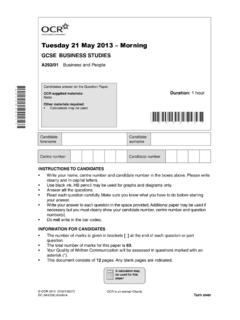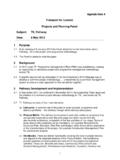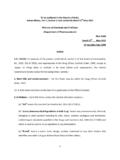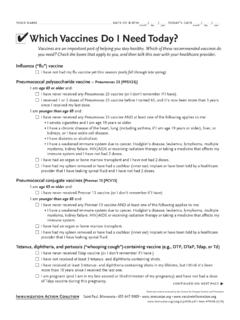Transcription of Illustrative Examples Exposure Draft ED/2013/6
1 Illustrative ExamplesExposure Draft ED/ 2013 /6 May 2013 Comments to be received by 13 September 2013 LeasesIllustrative Examples onExposure DraftLeasesComments to be received by 13 September 2013 These Illustrative Examples accompany the Exposure Draft ED/ 2013 /6 Leases(issued May2013; see separate booklet). The proposals may be modified in the light of the commentsreceived before being issued in final form. Comments need to be received by13 September2013and should be submitted in writing to the address below or electronically via ourwebsite using the Comment on a proposal responses will be put on the public record and posted on our website unless therespondent requests confidentiality.
2 Confidentiality requests will not normally be grantedunless supported by good reason, such as commercial :the IASB, the IFRS Foundation, the authors and the publishers do not acceptresponsibility for any loss caused by acting or refraining from acting in reliance on thematerial in this publication, whether such loss is caused by negligence or Financial Reporting Standards (including International Accounting Standardsand SIC and IFRIC Interpretations), Exposure Drafts and other IASB and/or IFRS Foundationpublications are copyright of the IFRS 2013 IFRS Foundation ISBN for this part: 978-1-907877-94-0; ISBN for set of three parts: 978-1-907877-91-9 All rights of the Exposure Draft may only be made for the purpose ofpreparing comments to be submitted to the IASB provided that such copies are for personalor intra-organisational use only and are not sold or disseminated and each copyacknowledges the IFRS Foundation s copyright and sets out the IASB s address in as permitted above no part of this publication may be translated, reprinted,reproduced or used in any form either in whole or in part or by any electronic, mechanicalor other means, now known or hereafter invented, including photocopying and recording,or in any information storage and retrieval system.
3 Without prior permission in writingfrom the IFRS approved text of International Financial Reporting Standards and other IASB publications is that published by the IASB in the English language. Copies may be obtainedfrom the IFRS Foundation. Please address publications and copyright matters to:IFRS Foundation Publications Department1st Floor, 30 Cannon Street, London EC4M 6XH, United KingdomTel: +44 (0)20 7332 2730 Fax: +44 (0)20 7332 2749 Email: Web: IFRS Foundation logo/the IASB logo/ Hexagon Device , IFRS Foundation , eIFRS , IASB , IFRS for SMEs , IAS , IASs , IFRIC , IFRS , IFRSs , SIC , International AccountingStandards and International Financial Reporting Standards are Trade Marks of the IFRS Foundation is a not-for-profit corporation under the General Corporation Law ofthe State of Delaware, USA and operates in England and Wales as an overseas company(Company number.)
4 FC023235) with its principal office as [ Draft ] IFRS XLEASESILLUSTRATIVE EXAMPLESINTRODUCTIONIE1 IDENTIFYING A LEASEIE3 example 1 Contract for rail carsExample 2 Contract for coffee servicesExample 3 Contract for medical equipmentExample 4 Contract for fibre-optic cableExample 5 Contract for energy/powerALLOCATING CONSIDERATION TO COMPONENTS OF A CONTRACTIE4 example 6 Lessee allocation of consideration to lease and non-leasecomponents of a contractLEASE COMPONENTS AND IDENTIFYING THE PRIMARY ASSETIE5 example 7 Lease of retail spaceExample 8 Lease of retail space plus an additional plot of landExample 9 Lease of a manufacturing plantExample 10 Lease of a turbine plantSHORT-TERM LEASEIE6 example 11 Short-term leaseLEASE
5 CLASSIFICATIONIE7 example 12 Equipment lease classificationExample 13 Commercial property lease classificationLESSEE MEASUREMENT AND REASSESSMENT OF THE LEASE TERMIE8 example 14 Initial and subsequent measurement by a lessee and accountingfor a change in the lease termExample 15 Termination penaltiesLESSEE ACCOUNTING FOR PURCHASE OPTIONSIE9 example 16 Purchase optionLESSEE ACCOUNTING FOR VARIABLE LEASE PAYMENTSIE10 example 17 Variable lease payments that are in-substance fixed leasepaymentsExample 18 Variable lease payments dependent on an index and variablelease payments linked to performanceLESSOR MEASUREMENT FOR TYPE A LEASESIE12 example 19 Lessor accounting for Type A leases the carrying amount of theunderlying asset equals fair valueExample 20 Lessor accounting for Type A leases the carrying amount of theunderlying asset is lower than fair valueExample 21 Lessor accounting for Type A leases residual value guaranteesExample 22 Lessor accounting for Type A leases impairment of the leasereceivableSALE AND LEASEBACK TRANSACTIONIE15 example 23 Sale and leaseback transactionLESSEE TRANSITION OPERATING LEASE TO TYPE A LEASEIE16 example 24 Lessee transition operating lease to Type A leaseILLUSTRATIVEEXAMPLES ONLEASES IFRS Foundation3 LESSEE TRANSITION OPERATING LEASE TO TYPE B LEASEIE17 example 25 Lessee transition operating lease to Type B
6 LeaseLESSOR TRANSITION OPERATING LEASE TO TYPE A LEASEIE18 example 26 Lessor transition operating lease to Type A leaseEXPOSUREDRAFT MAY2013 IFRS Foundation4[ Draft ] International Financial Reporting Standard XLeasesIllustrative examplesThese Examples accompany the [ Draft ] Standard. They illustrate aspects of the [ Draft ] Standard butare not intended to provide interpretative following Examples illustrate how an entity might apply some of therequirements in the [ Draft ] Standard to particular aspects of a lease (or othercontracts) based on the limited facts presented. Additional facts would mostprobably be required to fully evaluate the contract, which could change theevaluations following each Examples correspond with the following topics in the [ Draft ] Standard:(a)identifying a lease (paragraph IE3);(b)allocating consideration to components of a contract (paragraph IE4);(c)lease components and identifying the primary asset (paragraph IE5);(d)short-term lease (paragraph IE6);(e)lease classification (paragraph IE7);(f)lessee measurement and reassessment of the lease term (paragraph IE8);(g)lessee accounting for purchase options (paragraph IE9);(h)lessee accounting for variable lease payments (paragraphs IE10 IE11).
7 (i)lessor measurement for Type A leases (paragraphs IE12 IE14);(j)sale and leaseback transaction (paragraph IE15);(k)lessee transition operating lease to Type A lease (paragraph IE16);(l)lessee transition operating lease to Type B lease (paragraph IE17); and(m) lessor transition operating lease to Type A lease (paragraph IE18).ILLUSTRATIVEEXAMPLES ONLEASES IFRS Foundation5 Identifying a leaseIE3 The following Examples illustrate how an entity determines whether a contractis, or contains, a 1 Contract for rail carsExample 1A: A contract between Customer and a freight carrier (Carrier) providesCustomer with the use of 10 rail cars of a particular specification owned by Carrier forfive years.
8 The contract specifies the type of car. Customer determines when, where andwhich goods are to be transported using the cars. When the cars are not in use, theyare kept at Customer s premises. Customer can use the cars for another purpose (forexample, storage) if it so chooses. If a particular car needs to be serviced or repaired,Carrier is required to substitute an equivalent car of the same type. Otherwise, andother than on default by Customer, Carrier cannot retrieve the cars during the contract also requires Carrier to provide an engine and a driver when requested byCustomer and stipulates that, if Carrier is unable to do so, Customer has the right tohire an engine and a driver from other suppliers.
9 Carrier keeps the engines at itspremises and provides instructions to the driver detailing Customer s requests totransport goods. Carrier can choose to use any one of a number of engines to fulfil eachof Customer s requests, and one engine could be used to transport not only Customer sgoods, but also the goods of other customers (ie if other customers require the transportof goods to destinations close to the destination requested by Customer and within asimilar timeframe, Carrier can choose to attach up to 100 rail cars to the engine).The contract contains a lease of rail cars. Customer has the right to use 10rail cars for five of the contract depends on the use of 10 identified cars.
10 Oncedelivered to Customer, Carrier can substitute the cars only when they are notoperating has the right to control the use of the cars because of both of thefollowing:(a)Customer has the ability to direct the use of the cars. Customerdetermines how, when and for what purpose the cars are used, notonly when they are being used to transport Customer s goods butthroughout the term of the contract.(b)Customer has the ability to derive the benefits from use of the cars are available for Customer s use throughout the term of thecontract, including when they are not being used to transportCustomer s contract also contains a non-lease (service) component that relates to theuse of an engine and a driver.
















